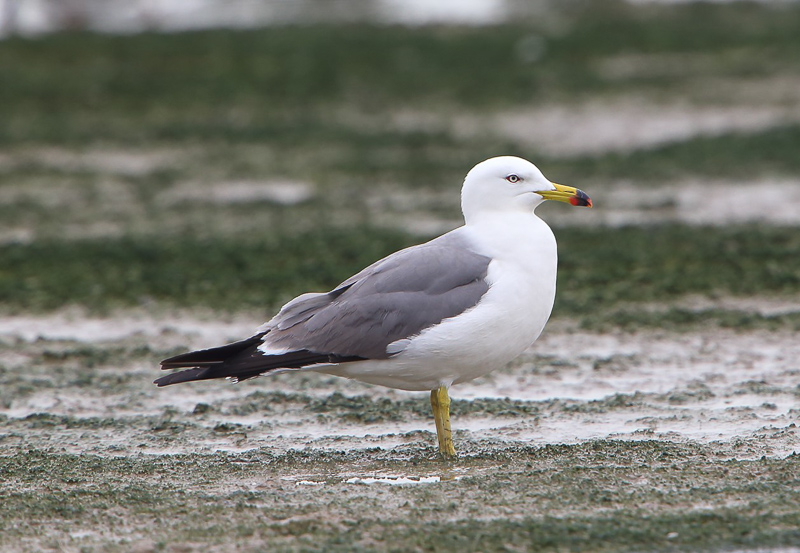Black-tailed Gull Larus crassirostris 黑尾鷗
Category I. Uncommon passage migrant and scarce winter visitor to coastal waters.
IDENTIFICATION

Mar. 2014, Michelle and Peter Wong. First-winter.
43-51 cm. Medium-sized fairly long-winged and short-tailed gull, the latter all or largely black at all ages.
Most birds occurring in HK are in first-winter plumage which consists of pale dull greyish-brown mantle and scapulars contrasting with brown wing coverts, extensive greyish-brown wash to hind neck, chest and flanks, dark flight feathers, black tail, pale greyish-pink legs and bill, the latter with a broad black tip.

Feb. 2023, Eva Lau. First-winter.
First-year birds appear rather dark and uniform in flight with plain dark brown flight feathers and wing coverts contrasting with a paler more greyish mantle, blackish barred rump and all-black tail. The paler head contrasts with a broad darker diffuse collar.
Second year birds have dull brownish-grey upperwings, broad black tail band with black extending up inner webs to uppertail coverts, well streaked rear half of head often with irregular greyish hind collar, pale bill with blackish tip.

Feb. 2018, Michelle and Peter Wong. Adult.
Adults have slate grey upperparts, a broad black tail band, narrow white tips to outer primaries (usually) and yellow bill with black subterminal band and red tip; eyes are pale with a red orbital ring.
Third-winters can be aged by slightly duller bill colouration, dark marks in primary coverts and more extensive black in the tail.
VOCALISATIONS
Distinctive rather nasal ‘kyow’, ‘kyee’, ‘kyooo’ or similar.
DISTRIBUTION & HABITAT PREFERENCE
Black-tailed Gull is more likely to be found away from the major gull concentration in Deep Bay, and the largest numbers have been recorded in Tolo Harbour and offshore waters where other gulls are not regularly seen. In Deep Bay Black-tailed Gull is scarce and the wintering population there ranges between two and usually not more than 12 individuals.
OCCURRENCE
First recorded in 1970, Black-tailed Gull is largely a passage migrant in spring from the second week of February to the third week of March, and it is scarce in the early and midwinter periods (Figure 1). It is rare in summer, having only been recorded in seven years this century from May to August.
Records before November are unusual, and numbers remain very low to the end of the year. It is only in January that numbers rise appreciably, though this is partly due to higher diurnal tides in Deep Bay. Most birds have left by the end of March, but it is not unusual to find a lingering bird in early April.
Black-tailed Gull is scarce in some years and relatively numerous in others, and this remains largely unchanged.
Figure 2 shows the scale of large influxes that occurred in the mid-1970s, and the winters of 1984/1985, 2002/03 and 2011/12 to 2013/14. These influxes were most conspicuous in areas such as Tolo Harbour, Starling Inlet and southern waters, with the highest count in Deep Bay being 110. The highest counts in HK are 293 at Sham Chung on 22 February 2003 and 200 at Starling Inlet on 17 February 1985 and off south Lantau on 8 March 2014.
Flocks of birds are occasionally noted on active migration, the largest being 114 near Po Toi on 6 March and 86 over Lok Ma Chau on 19 March. The higher counts have been made from 21 February to 19 March indicating they comprise migrants rather than wintering birds.
A small wintering population was present in Victoria Harbour and between Kwai Chung and Castle Peak from the 1960s to the early 1980s, but the last record from this area was on 16 December 1985.
First-winter birds predominate and constitute 85-90% of all records. Second-winter birds make up no more than 10% of the population and adults are recorded less than annually. However, in the 1984-1985 influx there were at least ten adults present together with approximately 200 immatures.
BEHAVIOUR, FORAGING & DIET
Small fish and organic waste are taken in coastal waters, though it presumably also feeds on crustaceans and polychaetes in Deep Bay.
Black-tailed Gulls do not usually form large concentrations, instead occurring either singly or in small flocks of less than ten birds, and even when small numbers do occur as in Deep Bay they rarely associate together.
RANGE & SYSTEMATICS
Monotypic. Breeds coastally from southern Ussuriland through Japan, Korea and east China to Fujian; disperses in winter regularly as far south as Hong Kong, but small numbers also reach areas from Hainan west to Indochina (Burger et al. 2020). In China breeds on islands in the Yellow Sea and winters from this area south to south coastal areas (Liu and Chen 2020).
CONSERVATION STATUS
IUCN: Least Concern. Population trend stable.
Figure 1.

Figure 2.

Burger, J., M. Gochfeld, G. M. Kirwan, and E. F. J. Garcia (2020). Black-tailed Gull (Larus crassirostris), version 1.0. In Birds of the World (J. del Hoyo, A. Elliott, J. Sargatal, D. A. Christie, and E. de Juana, Editors). Cornell Lab of Ornithology, Ithaca, NY, USA. https://doi.org/10.2173/bow.bktgul.01
Liu, Y. and Y. H. Chen (eds) (2020). The CNG Field Guide to the Birds of China (in Chinese). Hunan Science and Technology Publication House, Changsha.

